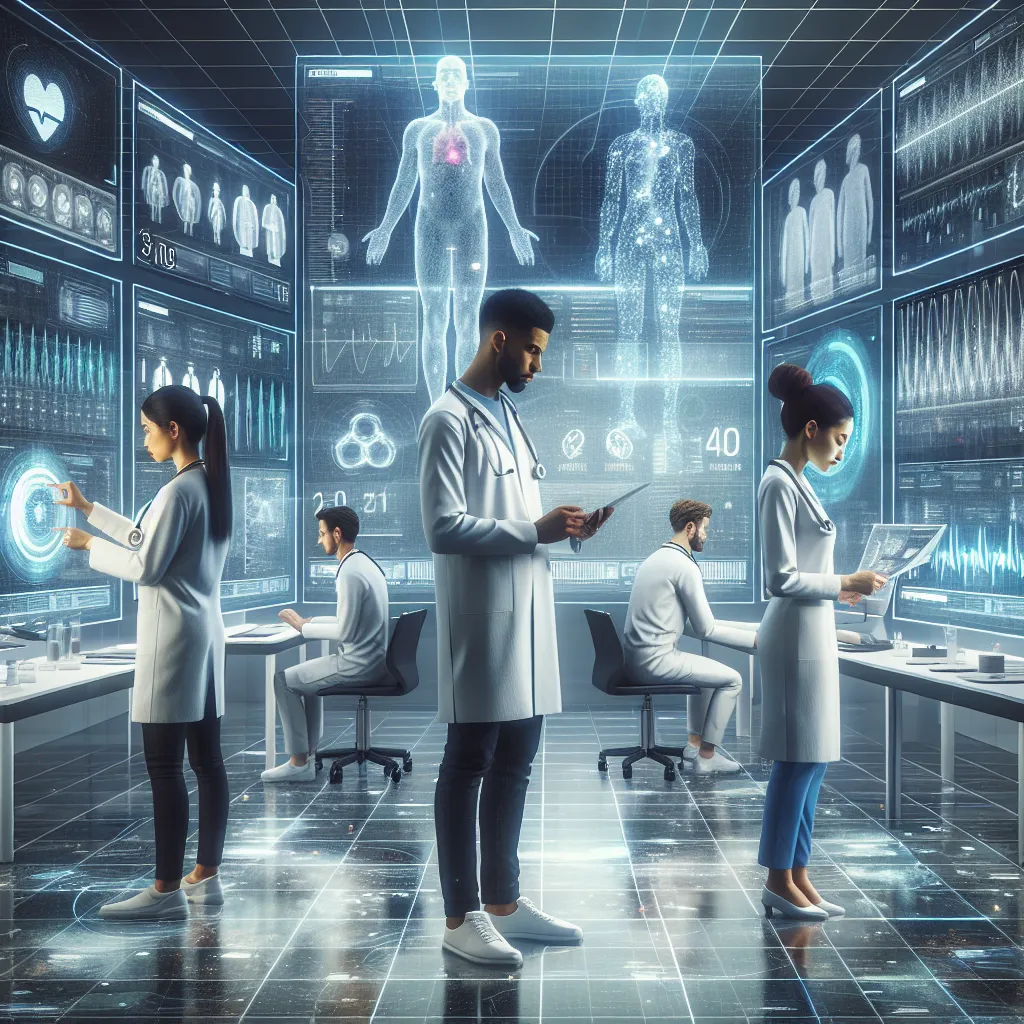The IELTS Reading section tests your ability to understand complex texts and answer questions accurately within a limited time frame. One increasingly popular topic in recent years is the impact of big data on various industries, particularly healthcare. This subject has appeared in several past IELTS exams and, given its growing relevance, is likely to feature again in future tests.
Today, we’ll explore a reading passage on “Big data’s impact on healthcare” to help you prepare for this potential exam topic. This practice will enhance your reading comprehension skills and familiarize you with the type of content and questions you might encounter in the actual IELTS test.
 Big Data in Healthcare
Big Data in Healthcare
Reading Passage: The Revolution of Big Data in Healthcare
Healthcare is undergoing a profound transformation, driven by the power of big data. This revolution is reshaping how medical professionals diagnose diseases, treat patients, and manage healthcare systems. The integration of vast amounts of data from various sources is opening up new possibilities for personalized medicine, improved patient outcomes, and more efficient healthcare delivery.
One of the most significant impacts of big data in healthcare is in the realm of predictive analytics. By analyzing large datasets of patient information, including genetic data, medical history, and lifestyle factors, healthcare providers can identify individuals at high risk for certain diseases before symptoms appear. This proactive approach allows for early intervention and preventive care, potentially saving lives and reducing the overall cost of healthcare.
Moreover, big data is enhancing the accuracy of diagnoses. Machine learning algorithms, trained on extensive medical databases, can assist doctors in interpreting medical images and test results with greater precision than ever before. For instance, AI systems have shown remarkable accuracy in detecting certain types of cancer from radiological images, sometimes outperforming human experts.
The pharmaceutical industry is also benefiting from big data. Drug discovery and development processes, which traditionally took years and cost billions, are being accelerated through the analysis of vast chemical and biological datasets. This not only speeds up the introduction of new treatments but also helps in identifying potential side effects and drug interactions more effectively.
Patient care is another area seeing significant improvements. Electronic Health Records (EHRs) allow for the seamless sharing of patient information across different healthcare providers, ensuring more coordinated and efficient care. Additionally, wearable devices and health apps are generating a wealth of real-time data about patients’ vital signs and activities, enabling more personalized and timely interventions.
However, the integration of big data in healthcare is not without challenges. Privacy concerns are paramount, as health data is highly sensitive. Ensuring the security of this information while making it accessible to those who need it is a complex balancing act. There are also issues of data quality and standardization, as well as the need for healthcare professionals to be trained in data analysis and interpretation.
Despite these challenges, the potential benefits of big data in healthcare are immense. From improving public health through better disease surveillance and outbreak prediction to optimizing hospital operations and resource allocation, big data is set to revolutionize every aspect of healthcare. As we move forward, the integration of big data analytics with other emerging technologies like artificial intelligence and the Internet of Things promises to usher in a new era of data-driven, highly personalized healthcare.
Questions
True/False/Not Given
- Big data is transforming healthcare by enabling personalized medicine and improving patient outcomes.
- Predictive analytics in healthcare can identify disease risks before symptoms appear.
- AI systems are always more accurate than human experts in interpreting medical images.
- Big data has reduced the cost and time required for drug discovery and development.
- Electronic Health Records (EHRs) allow patients to directly access their medical information.
- The use of big data in healthcare is completely secure and free from privacy concerns.
- Healthcare professionals require additional training to effectively use big data analytics.
Multiple Choice
-
According to the passage, which of the following is NOT mentioned as a benefit of big data in healthcare?
A) Improved accuracy in disease diagnosis
B) Enhanced drug discovery processes
C) Reduced need for medical professionals
D) More efficient healthcare delivery -
The passage suggests that wearable devices and health apps:
A) Are replacing traditional medical treatments
B) Generate real-time data about patients’ health
C) Are mainly used for fitness tracking
D) Have completely solved the issue of patient monitoring
Matching Headings
Match the following headings to the appropriate paragraphs in the passage:
- Challenges in implementing big data in healthcare
- The role of big data in pharmaceutical research
- Enhancing diagnostic accuracy through data analysis
- The future potential of big data in healthcare
Short Answer Questions
-
What type of data do predictive analytics use to identify individuals at high risk for certain diseases? (No more than 3 words)
-
Name two emerging technologies mentioned in the passage that could further enhance the impact of big data in healthcare. (No more than 6 words)
Answer Key and Explanations
-
True – The passage states that big data is “reshaping how medical professionals diagnose diseases, treat patients, and manage healthcare systems.”
-
True – The text mentions that “healthcare providers can identify individuals at high risk for certain diseases before symptoms appear.”
-
Not Given – While the passage states that AI systems have shown remarkable accuracy, sometimes outperforming human experts, it doesn’t claim they are always more accurate.
-
True – The passage indicates that big data is accelerating drug discovery and development processes, which traditionally took years and cost billions.
-
Not Given – The passage mentions EHRs allow for sharing of patient information among healthcare providers, but doesn’t specify patient access.
-
False – The passage explicitly mentions privacy concerns and the challenge of ensuring data security.
-
True – The text states there is a “need for healthcare professionals to be trained in data analysis and interpretation.”
-
C – The passage does not mention reducing the need for medical professionals as a benefit of big data in healthcare.
-
B – The passage states that “wearable devices and health apps are generating a wealth of real-time data about patients’ vital signs and activities.”
-
Paragraph 6
-
Paragraph 4
-
Paragraph 3
-
Paragraph 7
-
Genetic data, medical history (Accept any combination of these within the word limit)
-
Artificial intelligence, Internet of Things
Common Mistakes to Avoid
- Overgeneralizing: Be cautious about making broad statements not directly supported by the text.
- Misinterpreting “Not Given”: Remember, this option means the information is neither confirmed nor contradicted by the passage.
- Overlooking specific details: Pay close attention to qualifiers like “sometimes” or “potentially” in the text.
- Time management: Don’t spend too much time on difficult questions; move on and return if time allows.
Key Vocabulary
- Profound transformation (phrase): Deep, significant change
- Predictive analytics (n): Use of data to forecast future events
- Proactive approach (phrase): Acting in anticipation of future problems
- Machine learning algorithms (n): Computer programs that can learn and adapt
- Seamless sharing (phrase): Smooth, uninterrupted exchange of information
- Privacy concerns (n): Worries about the protection of personal information
- Data standardization (n): The process of bringing data into a common format
Grammar Focus
Complex sentences with multiple clauses are common in academic texts. For example:
“By analyzing large datasets of patient information, including genetic data, medical history, and lifestyle factors, healthcare providers can identify individuals at high risk for certain diseases before symptoms appear.”
This sentence structure allows for the presentation of detailed information concisely. Practice identifying the main clause and dependent clauses in such sentences to improve your understanding of complex texts.
Tips for IELTS Reading Success
- Skim the passage quickly before reading in detail to get a general idea of the content.
- Read the questions carefully and underline key words.
- Use the headings and first sentences of paragraphs to help you locate information quickly.
- Practice time management – allocate your time wisely across all questions.
- For True/False/Not Given questions, look for specific evidence in the text to support your answer.
- Improve your vocabulary related to technology and healthcare, as these topics are increasingly common in IELTS Reading tests.
- Regularly read academic articles on various subjects to familiarize yourself with complex sentence structures and academic vocabulary.
Remember, consistent practice with diverse reading materials is key to improving your IELTS Reading score. Focus on understanding the main ideas and supporting details, and always base your answers on the information provided in the passage.


